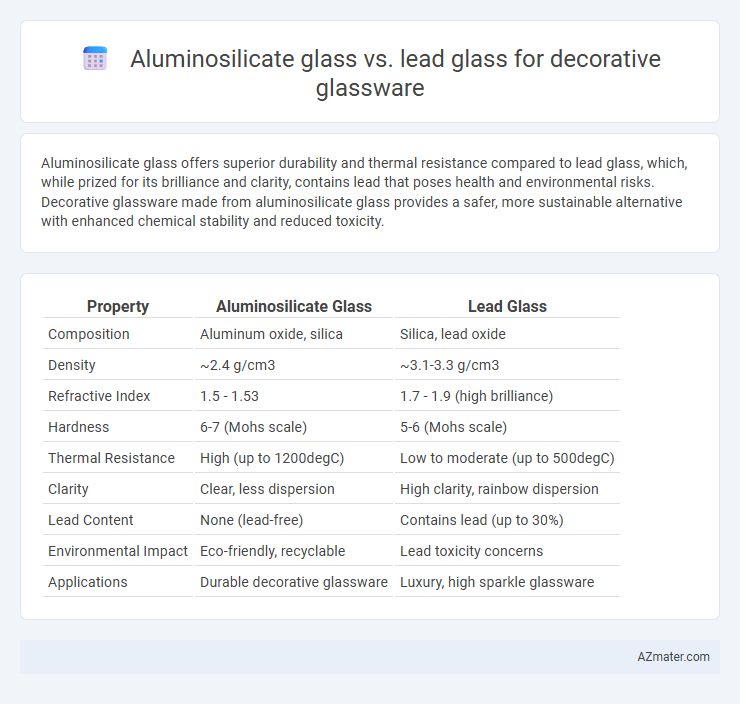Aluminosilicate glass offers superior durability and thermal resistance compared to lead glass, which, while prized for its brilliance and clarity, contains lead that poses health and environmental risks. Decorative glassware made from aluminosilicate glass provides a safer, more sustainable alternative with enhanced chemical stability and reduced toxicity.
Table of Comparison
| Property | Aluminosilicate Glass | Lead Glass |
|---|---|---|
| Composition | Aluminum oxide, silica | Silica, lead oxide |
| Density | ~2.4 g/cm3 | ~3.1-3.3 g/cm3 |
| Refractive Index | 1.5 - 1.53 | 1.7 - 1.9 (high brilliance) |
| Hardness | 6-7 (Mohs scale) | 5-6 (Mohs scale) |
| Thermal Resistance | High (up to 1200degC) | Low to moderate (up to 500degC) |
| Clarity | Clear, less dispersion | High clarity, rainbow dispersion |
| Lead Content | None (lead-free) | Contains lead (up to 30%) |
| Environmental Impact | Eco-friendly, recyclable | Lead toxicity concerns |
| Applications | Durable decorative glassware | Luxury, high sparkle glassware |
Introduction to Decorative Glassware: Material Choices
Aluminosilicate glass offers superior chemical durability and high thermal resistance, making it ideal for decorative glassware that requires longevity and strength. Lead glass, known for its high refractive index and brilliance, excels in enhancing the aesthetic appeal with its exceptional clarity and sparkle. Material choice in decorative glassware hinges on the balance between durability needs and desired optical effects, with aluminosilicate glass favored for robustness and lead glass prized for visual elegance.
Aluminosilicate Glass: Composition and Properties
Aluminosilicate glass, primarily composed of silica (SiO2) and alumina (Al2O3), offers superior mechanical strength and enhanced thermal resistance compared to lead glass, making it ideal for durable decorative glassware. This glass type exhibits excellent chemical stability and hardness, reducing susceptibility to scratches and damage over time. Its low thermal expansion coefficient also ensures dimensional stability under temperature changes, contributing to long-lasting aesthetic appeal in decorative applications.
Lead Glass: Composition and Distinctive Features
Lead glass, also known as crystal glass, contains a high proportion of lead oxide, typically between 18% and 40%, which enhances its refractive index and imparts exceptional brilliance and clarity, making it highly prized for decorative glassware. This composition increases density and weight, producing a distinctive ring when tapped that signifies quality and craftsmanship, setting it apart from aluminosilicate glass. The lead content also allows for superior workability and the ability to be finely cut or engraved, resulting in intricate decorative designs favored in luxury glassware collections.
Visual Appeal: Clarity and Luster Comparison
Aluminosilicate glass offers superior clarity with high resistance to yellowing, providing a consistently bright and clear visual appeal in decorative glassware. Lead glass, known for its high refractive index, delivers exceptional brilliance and luster, producing a sparkling effect that enhances decorative designs. While lead glass excels in light dispersion, aluminosilicate glass maintains long-term clarity, making both materials distinct choices based on desired visual characteristics.
Durability and Resistance: Aluminosilicate vs Lead Glass
Aluminosilicate glass offers superior durability and higher resistance to thermal shock compared to lead glass, making it ideal for decorative glassware that requires long-lasting strength. Lead glass, while prized for its brilliant clarity and weight, is more prone to scratching and less resistant to impact, limiting its durability in everyday use. The higher chemical resistance of aluminosilicate glass also enhances its ability to maintain appearance and structural integrity over time.
Workability and Design Flexibility for Artisans
Aluminosilicate glass offers superior workability for artisans due to its higher thermal shock resistance and durability, allowing intricate shaping without compromising strength. Lead glass, known for its brilliance and weight, provides excellent design flexibility with its lower melting point and softness, enabling detailed engraving and cutting. While aluminosilicate glass suits robust, complex forms, lead glass excels in delicate, ornate decorative glassware requiring fine craftsmanship.
Safety and Health Considerations
Aluminosilicate glass exhibits superior chemical durability and thermal shock resistance, making it safer for decorative glassware by reducing risks of breakage and leaching of harmful substances. Lead glass, while prized for its brilliance and clarity, poses significant health concerns due to lead content, which can leach into liquids and food, especially over time. Choosing aluminosilicate glass minimizes exposure to toxic elements, enhancing safety and health in everyday use.
Environmental Impact and Sustainability
Aluminosilicate glass offers a more environmentally friendly option for decorative glassware due to its lower lead content, reducing toxic waste and health hazards associated with lead glass. Its higher durability and recyclability enhance sustainability by extending product lifespan and minimizing landfill contributions. Lead glass, while prized for optical clarity, poses significant environmental challenges through lead pollution and difficulties in recycling processes.
Cost Effectiveness for Decorative Glassware Production
Aluminosilicate glass offers superior durability and scratch resistance compared to lead glass, making it cost-effective in long-term decorative glassware production by reducing replacement and maintenance expenses. Lead glass, while clearer and more brilliant due to its high refractive index, incurs higher material and health compliance costs, impacting overall production budgets. Manufacturers prioritize aluminosilicate glass for cost efficiency in large-scale decorative glassware where durability and lower health risks align with budget constraints.
Choosing the Right Glass for Decorative Applications
Aluminosilicate glass offers superior durability, scratch resistance, and thermal stability, making it ideal for long-lasting decorative glassware exposed to daily use or varying temperatures. Lead glass, known for its high refractive index and brilliance, provides exceptional clarity and sparkle, enhancing the aesthetic appeal of luxury decorative pieces. Selecting the right glass depends on balancing the need for structural strength with optical elegance to achieve both functional resilience and visual impact in decorative applications.

Infographic: Aluminosilicate glass vs Lead glass for Decorative glassware
 azmater.com
azmater.com